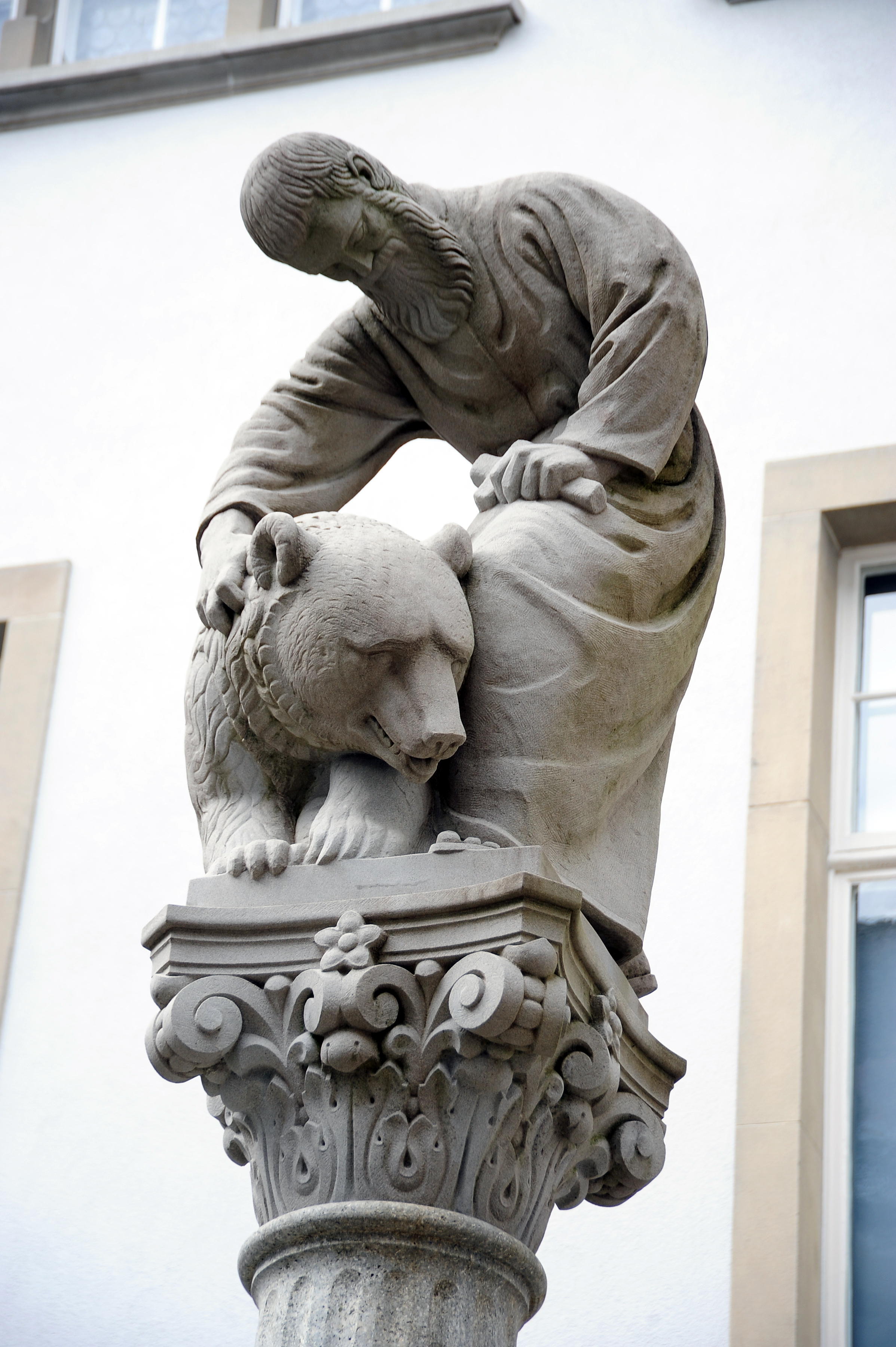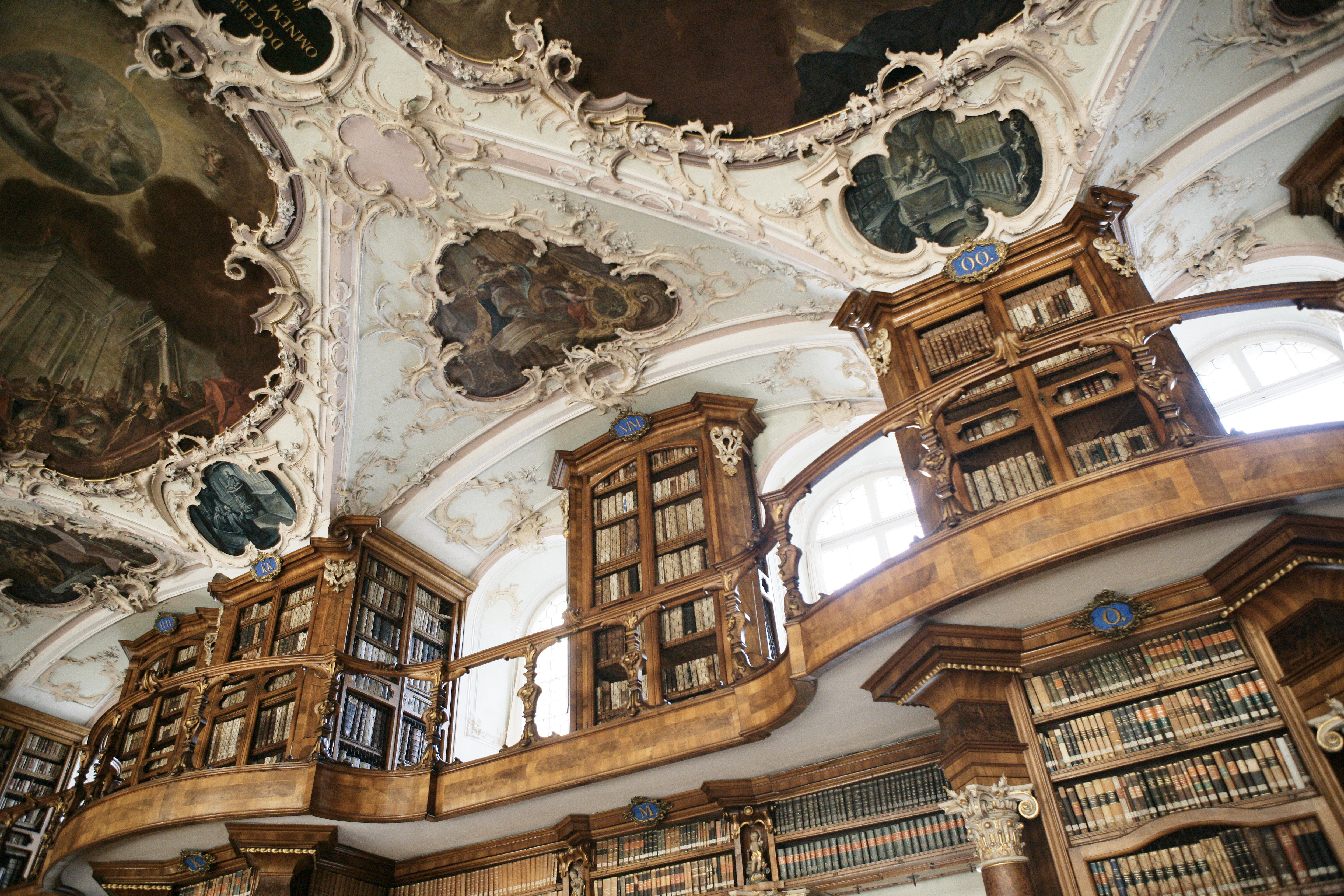World Heritage city celebrates its patron saint

Legend has it that the monk Gallus built a hermitage 1,400 years ago in a spot that would later became the World Heritage city of St Gallen. The city’s anniversary is now being marked, but questions still linger over Gallus’ origins.
Documents put Gallus as coming from Bangor in Northern Ireland, but not everyone agrees. Recently, historian Max Schär published a book arguing that Gallus came from Alsace because he could understand and preach in German.
But according to Ernst Tremp, head librarian of the St Gallen Abbey Library, which is running an exhibition devoted to St Gallus, he was a monk in the early seventh century and a pupil of St Columbanus of Ireland.
“He separated himself from St Columbanus’ monks and settled in the Steinach valley, where there was of course no city and no abbey,” he told swissinfo.ch.
“He first of all built a chapel and lived there for several decades, preaching and doing good works. He died around 640 and is buried here. Later an abbey was erected around his grave, which existed until 1800.”
Tremp says there are good arguments for both theses.
“It’s best to leave it open as it’s not crucial. What is more crucial is that Gallus was really a pupil of St Columbanus, that he saw himself as an Irish pupil monk, lived according to St Columbanus’ strict rules, so he understood himself in the tradition of the Irish monks,” said Tremp, also a professor of history at Fribourg University.
According to these early accounts, Gallus moved, as one of his mentor’s 12 companions, from Bangor via Luxeuil and Metz, up the Rhine to Lake Constance. In 612 Gallus separated from the group and followed the River Steinach south.
He stumbled among the wild vegetation of the Mülenenschlucht gorge and interpreting this as a sign from God, decided to stay there.
Another story, exquisitely depicted in a ninth century ivory tablet on show in the exhibition, the oldest illustration of the legend, tells of Gallus instructing a bear to get wood for the fire and the bear being rewarded with some bread. The bear is depicted in the city of St Gallen’s coat of arms.
Pilgrimage
After Gallus’ death, his grave – elevated by a bishop to a sarcophagus – became a place of pilgrimage and Gallus was accepted as a saint, there being no official canonic procedure at the time.
“We don’t know where the grave is anymore and the sarcophagus doesn’t exist anymore. But in what is now the abbey church there is a crypt containing a modern reliquary casket in which the remains of Gallus’ skull can be seen,” Tremp explained.
A monastery was founded around 100 years after Gallus’ death and grew to become an important school of learning. The city subsequently grew, gaining an economic boost from its embroidery industry. Since 1983 the abbey and church precinct has been a Unesco World Heritage site.
Pilgrimages may have tailed off since the 1960s, but the saint has certainly left his imprint, giving his name to the city, surrounding canton and the bishopric. People celebrate Gallus day on October 16.
As part of the jubilee, four inhabitants of St Gallen have decided though to follow Gallus’ legendary footsteps, walking all the way from Bangor.
“I said to myself someone has to make the journey,” explained one of the participants, Richard Frei, before setting off.
“It will be a challenge to find the road the Gallus took,” he told swissinfo.ch. “We will spend a lot of time on asphalt as well as climbing mountains and hills. Hopefully we will meet people who will be interested in talking about our journey.” (See audio feature)
On the map
Thomas Scheitlin, the city’s mayor, describes 2012 as a very important year for St Gallen. The official celebrations started in April and continue until October. They include several exhibitions as well as installations by international artists in the Mülenenschlucht gorge.
He hopes that the jubilee will put the eastern Swiss city – known chiefly for its university and for being a Unesco site – more firmly on the international map.
“My hopes are that the story of St Gallus becomes better known and that people who come to St Gallen will see what the city represents, starting with the Unesco world cultural heritage, the cathedral and all the artistic installations.”
“Gallus is present everywhere in the city,” he told swissinfo.ch.
The anniversary year started with three weeks of opening festivities starting in April.
One new attraction, which will be repeated in the following years, is being held in the Mülenenschlucht gorge: an exhibition of unusual installations by international artists Maria Eichhorn from Berlin, Bethan Huws from Paris/Wales, and Norbert Möslang from St Gallen.
Abbey Library exhibition: The Holy Gallus 612|2012 life-legend-cult, runs until November 11, 2012. It includes the library’s oldest treasures relating to St Gallus. There are also Irish texts, including the loan of the Antiphonary of Bangor, an early Irish manuscript (runs April-July).
Other exhibitions: the St Gallen Museum of History and Ethnography: Gallus – Cult, Kitsch, Caricature. The Natural History Museum will be focusing on the bear as the Gallus symbol. The Textile Museum will be presenting textile treasures that were created in St Gallen for ecclesiastical purposes.
St Gallen lies in eastern Switzerland. The Abbey precinct with the cathedral and Abbey Library, home to around 140,000 documents, has been a Unesco World Heritage site since 1983.
In the Middle Ages, the town developed into an important hub of culture and education in Europe. From the 15th century, St Gallen embroideries attracted international recognition and brought prosperity. Although the industry has now declined, its embroideries are still in demand for haute couture.
St Gallen is now a university town with a focus on the economic sciences. There are around 160,000 residents in the city and agglomeration.

In compliance with the JTI standards
More: SWI swissinfo.ch certified by the Journalism Trust Initiative














You can find an overview of ongoing debates with our journalists here . Please join us!
If you want to start a conversation about a topic raised in this article or want to report factual errors, email us at english@swissinfo.ch.